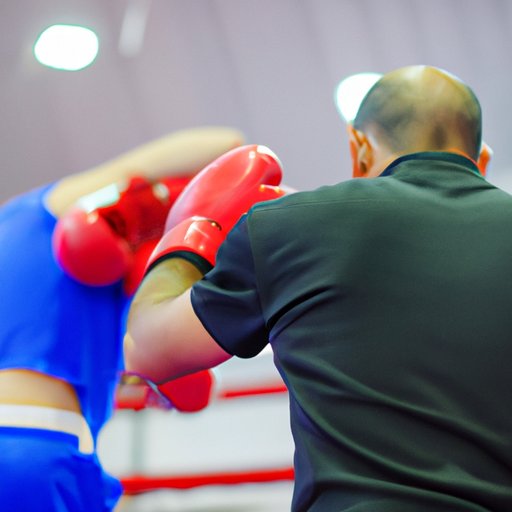
I. Introduction
If you’re new to boxing, you might be wondering what the different weight classes are and why they matter. In this article, we’ll explain what boxing weight classes are, the different divisions, and how they work. Understanding boxing weight classes is essential to fully appreciate the sport, whether you’re a fan or a fighter.
II. What are Boxing Weight Classes?
In boxing, weight classes are categories designed to keep fights fair by matching fighters of similar size, weight, and experience against each other. This ensures that no fighter has a significant advantage over their opponent.
Each weight class corresponds to a specific weight range, and there are 17 different weight classes in professional and amateur boxing.
III. The Different Boxing Weight Classes
Here are the 17 different weight classes in boxing, listed from the lightest to the heaviest:
1. Strawweight/Minimumweight
This division is for fighters who weigh no more than 105 pounds.
2. Light Flyweight
Fighters who weigh over 105 pounds to 108 pounds are categorized in this division.
3. Flyweight
This division is for fighters who weigh over 108 pounds to 112 pounds.
4. Super Flyweight/Junior Bantamweight
Fighters weighing over 112 pounds to 115 pounds are categorized in this division.
5. Bantamweight
This division is for fighters weighing over 115 pounds to 118 pounds.
6. Super Bantamweight/Junior Featherweight
Fighters weighing over 118 pounds to 122 pounds are categorized in this division.
7. Featherweight
This division is for fighters weighing over 122 pounds to 126 pounds.
8. Super Featherweight/Junior Lightweight
Fighters weighing over 126 pounds to 130 pounds are categorized in this division.
9. Lightweight
This division is for fighters weighing over 130 pounds to 135 pounds.
10. Super Lightweight/Junior Welterweight
Fighters weighing over 135 pounds to 140 pounds are categorized in this division.
11. Welterweight
This division is for fighters weighing over 140 pounds to 147 pounds.
12. Super Welterweight/Junior Middleweight
Fighters weighing over 147 pounds to 154 pounds are categorized in this division.
13. Middleweight
This division is for fighters weighing over 154 pounds to 160 pounds.
14. Super Middleweight
Fighters weighing over 160 pounds to 168 pounds are categorized in this division.
15. Light Heavyweight
This division is for fighters weighing over 168 pounds to 175 pounds.
16. Cruiserweight
Fighters weighing over 175 pounds to 200 pounds are categorized in this division.
17. Heavyweight
This division is for fighters weighing over 200 pounds.
IV. How Boxing Weight Classes Work
The weight class of each fighter can have a significant impact on the strategies, techniques, and gameplay. For instance, smaller fighters generally tend to be quicker and have more agility, while larger fighters often have more power.
It is essential to weigh in before a match to ensure that both fighters make the weight requirements for their respective weight classes. This adds an extra layer of fairness to the fight.
Catchweight bouts are also another option for fighters looking to compete outside of their categories. These matches stipulate a specific weight for the fight that is not part of the regular weight classes.
V. The Importance of Boxing Weight Classes
Weight classes play a vital role in ensuring fairness and equal competition between fighters. Without the different weight categories, smaller fighters would be at a significant disadvantage, and the larger fighters would dominate the sport.
Weight classes also serve as a way for boxers to prepare better and develop their specific fighting styles for their weight division.
VI. Tips for Navigating the World of Boxing Weight Classes
If you’re a fighter looking to enter a specific weight class, here are some tips to consider:
First, consult with a trainer or coach to determine your optimal weight class. This should be determined based on your physical attributes, skills, and experience.
Second, take a close look at your diet and workout routine to ensure that you can make the weight comfortably and healthily. Rapidly losing weight before a fight can lead to a decrease in strength and stamina.
If you’ve already decided on a weight class, focus on developing your fighting style and techniques suitable for your weight division.
VII. Conclusion
Boxing weight classes ensure that fighters compete on a level playing field, regardless of their experience or size. By understanding what weight classes are and how they work, you’ll be better equipped to appreciate the sport’s nuances. Whether you’re a fan or a fighter, weight classes are an essential part of boxing that contribute to the sport’s legacy and its continued popularity.
Call to Action: Whether you’re a fan or a fighter, take the time to learn more about boxing weight classes. By understanding the different divisions and weight ranges, you’ll be able to appreciate the nuances of the sport and the strategy involved in each fight.




